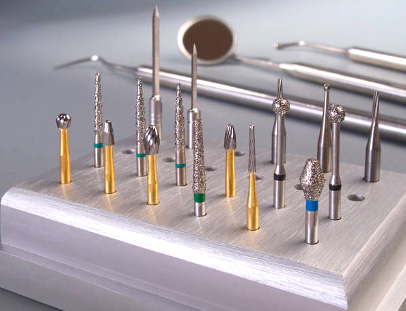Dental burs are among the most frequently used tools in a dental clinic. Whether you’re prepping a cavity, shaping a restoration, or contouring enamel, the right bur can make all the difference in achieving precision and efficiency.
However, their frequent use can sometimes lead us to overlook the small habits that help them perform better and last longer. By following a few simple best practices, you can extend the life of your burs, protect your equipment, and ultimately improve patient outcomes.

Here are some essential best practices for using dental burs effectively:
1. Use the Right Bur for the Right Procedure
Dental burs aren’t one-size-fits-all. There are different types of dental burs available in the market, and they vary in shape, size, and material. Each type is designed for specific clinical tasks. Choosing the right bur means you’ll get cleaner cuts, work more efficiently, and put less strain on your handpiece.
For example, diamond burs are ideal for fine cutting and polishing, while carbide burs are best for rapid reduction and trimming.
2. Maintain Proper Cooling
Rotary cutting naturally generates heat, which can be harmful to both the tooth and your bur. Always ensure adequate water spray or air-water cooling during use to avoid pulp damage and improve patient comfort.
3. Avoid Excessive Pressure
It’s tempting to apply more force to speed up a procedure, but heavy pressure can actually backfire. Too much pressure causes overheating, shortens the life of your bur, and can even damage tooth structure. Instead, let the bur’s sharp edges do the work.
4. Sterilize and Store Burs Properly
Infection control is critical in every dental practice. After each use, burs should be thoroughly cleaned, sterilized, and dried according to manufacturer’s guidelines. Proper storage is just as important to avoid cross-contamination and damage.
5. Inspect Burs Before and After Use
Worn-out or damaged burs can reduce cutting efficiency and cause microfractures in tooth enamel or restorations.Take a moment to inspect each bur before and after use. Look for signs of wear, bending, or dullness.
6. Match the Bur Speed to the Procedure
High-speed burs are not always ideal for every task. Not every procedure requires maximum speed. Using the correct RPM for each bur type and clinical task helps you maintain control and avoid damaging surrounding tissues.
7. Rotate Burs Regularly
Relying on the same burs for every procedure leads to uneven wear and unpredictable performance. By rotating your burs, you ensure consistent results and reduce the risk of unexpected tool failure.


